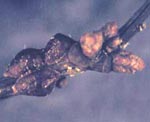Lecanium Scales
Lecanium spp.
Description

Figure 1. Lecanium
Scales
Lecanium scales vary greatly in size, color, and shape, depending somewhat on the host plant they inhabit. In general, after egg-laying the female scale turns brown, becomes brittle, and hemispherical. Before egg-laying, the scale may be quite flat or highly convex and may range from a light tan to a purplish-white. The lecanium scales range in size from the 1/8-inch terrapin scale up to the 1/2-inch hickory lecanium scale.
The different lecanium scales show distinct preferences for particular hosts. Fletcher scale prefers arborvitae and yew; terrapin scale, maples and peach; hickory lecanium scale, hickory and elm; globose scale, stone fruits; and European fruit lecanium scale, a wide variety of shade and fruit trees, shrubs, and woody ornamentals.
Life History
Most species of lecanium scale deposit their eggs during June or early July. As the eggs are laid, the body of the female becomes increasingly dry and hemispherical. The dead, brittle body of the female, the "scale," protects the eggs until they hatch. The emerging crawlers migrate to the leaves, except for Fletcher scale crawlers which remain on the branches of the arborvitae and yew throughout the year. In the late summer, after shedding their skins once, the crawlers return to the twigs to overwinter. The scales resume that development the following spring and undergo a period of rapid growth that continues into early summer and egg-laying.
The terrapin scale differs from most lecanium scales in that the young are born as crawlers in the spring. These crawlers migrate to the leaves where they remain until just before frost. It is the adult female, not the second-stage nymph, that overwinters. Generally, the terrapin scale and other lecanium scales have only one generation a year.
Damage
The lecanium scales, like other scale insects, feed on the sap of the host plant. If a tree is heavily infested, the competition for moisture among the lecanium scales will cause some dieback of twigs and branches, and premature leaf drop. During severe moisture stress, a heavy infestation could kill the entire tree. The heaviest damage occurs during the spring and early summer. In addition to causing moisture loss, lecanium scales produce honeydew that is colonized by black, sooty, mold fungi. Fletcher scale seldom causes any visible injury to arborvitae, but is a serious pest of yews.
Nonchemical Control
As with other scale insects, the populations of lecanium scale normally are regulated by the physical environment and natural parasites and predators.
Chemical Control
Crawler sprays should be applied around mid-June, and repeated two weeks later. Dormant oil sprays may also used for overwintering immature females.